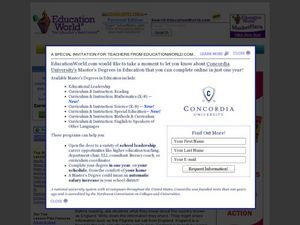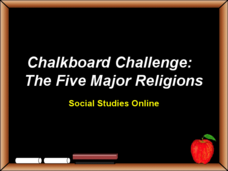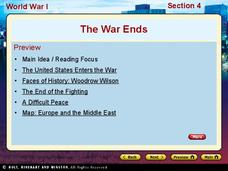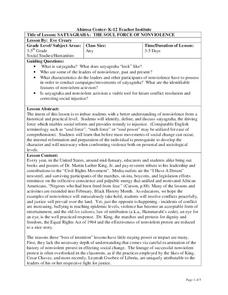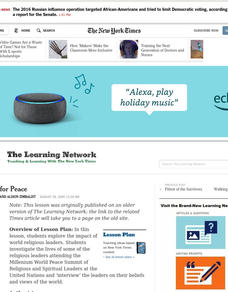Curated OER
Jefferson vs. Franklin: Revolutionary Philosophers
Middle schoolers cite connections among Franklin's Albany Plan of 1754, his Plan of Confederation of 1775 and the U.S. Constitution and/or the Declaration of Independence. In an essay, they give examples of the philosophical and...
Curated OER
Past Imperfect: Examining Secondary Sources of the American Revolution
Ninth graders respond in essay form to the following writing prompt. Mel Gibson, star of The Patriot, is quoted as stating, "If one were to adhere to historical accuracy all the way, you'd probably have the most boring two hours on...
Curated OER
British Royalty Tours the U.S.
Students share their knowledge of England, then read a news article about Prince Charles's anticipated visit to the U.S. In this current events lesson (written prior to Prince Charles's visit), the teacher introduces the article with a...
Curated OER
Bill of Rights
Students work in collaborative groups to research an amendment of the Bill of Rights. They then design and present a skit that demonstrates and communicates the core values and concepts of the amendment to the class.
Curated OER
Chalkboard Challenge: The Five Major Religions
Employing a game format, this Jeopardy-influenced game provides questions to help learners review information related to the study of world religions. The questions involve an exploration of the Hindu, Jewish, Christian, Islamic, and...
Curated OER
World War I
Using maps, diagrams, and lists, this resource is a wonderful way to review the main concepts involving WWI. There are charts with a comparison of imperialism and nationalism, and other key ideas that explain how Europe plunged into this...
Curated OER
World War I - The War Ends
Your class is in for a treat with this outstanding PowerPoint on World War I. The presentation is loaded with facts, maps, important personalities, and discussion questions on the war. Additionally, there is a wonderful video called,...
National Endowment for the Humanities
Martin Luther King, Jr. and Nonviolent Resistance
Was nonviolent resistance the best means of securing civil rights for black Americans in the 1960s? In this highly engaging and informative lesson, your young historians will closely analyze several key documents from the civil rights...
University of California
Roots of the Cold War
When and how did the Cold War begin? To answer this question, you will not find a better-organized, in-depth, activity- and inquiry-based resource than this! Executing best teaching practices throughout, each portion of this inquiry...
Clark County School District
Hollywood's Take on the Cuban Missile Crisis: Thirteen Days
Watching the film Thirteen Days is an engaging way of acquainting learners with the Cuban missile crisis, and this learning exercise is the perfect accompaniment for viewership! It includes 15 questions for your young historians to...
iCivics
Mock Election
Here is an excellent resource in which class members host a mock election for a candidate and policy that will be implemented into your very own classroom. Progressing from primaries, through the campaign trail, and finally to the mock...
Humanities Texas
A President's Vision: George Washington
Who knew that one poster about George Washington could have so many learning possibilities attached to it? Here you'll find an attractive learning display on the first president of the United States, as well as worksheets and...
National Endowment for the Humanities
Chronicling America: Uncovering a World at War
As part of a study of World War I, class members read newspaper articles from the time that urge American involvement, non-involvement, or neutrality. Using the provided worksheet, groups analyze the articles noting the central argument...
Gateways
Teaching the Easter Story
If you are looking for a secular approach to teaching about Easter, this may just be the resource for you. Pupils read a paraphrased text depicting the last supper, arrest, and crucifixion of Jesus Christ as told in the Bible, while also...
US Holocaust Museum
Deconstrucing the Familiar
Collaboration and complicity. Class members examine a series of photographs and consider how active participation and passive complicity represented in the photos contributed to the Holocaust.
Curated OER
Driving Safety and Distractions
Students research process necessary to add local or state law limiting such driving distractions as cell phones or other technological devices, interview city leaders or legislators, research areas that already have such legislation and...
Social Media Toolbox
Cyberbullying
What can we do to make our school community more aware of cyberbullying? From The Social Media Toolbox, instructional activity 10 of 16 takes on the tough topic of bullying. Learners research cyberbullying through online research, then...
Curated OER
Writing Women: The Yellow Wallpaper
Students examine the historical, social, cultural and economic context of Charlotte Perkins Gilman's story, The Yellow Wallpaper. Students determine the place of the middle class woman and her role in society.
Curated OER
North Korea's Power Play
Students research a number of websites to see how North Korea's leaders have shaped the country. They investigate Korea's ancient history and culture.
Curated OER
Satyagraha: The Soul Force of Nonvilence
Pupils discuss what satyagraha is understanding that it is the driving force which enables social reform. In this social science lesson, students try to internalize the principles of nonviolence on an individual level and then a global...
Curated OER
Power Builders: Leaders and Cities
Young scholars are explained that they are going to consider why cities are built and what needs they meet for their residents. They view a video "The Building of New York City." Students work in small groups to plan imaginary city. ...
Curated OER
PEOPLE OF THE FERTILE CRESCENT
Students evaluate how technology changed life in Mesopotamia. Students summarize the link between agriculture and religion in Sumer. Students classify the Sumerians according to social classes. Students classify the causes and effects...
Curated OER
Early America
Young scholars explore what a leader represents. In this social science lesson, students discuss what the traits, qualities, or characteristics are of a leader. Young scholars also understand that leaders existed in America's past and in...
Curated OER
Praying for Peace
Pupils investigate the lives of some of the religious leaders attending the Millennium World Peace Summit of Religious and Spiritual Leaders at the United Nations and 'interview' the leaders on their beliefs and views of the world.




